Surface Chemistry-Solutions
CBSE Class 12 Chemistry
NCERT Solutions
Chapter – 05
Surface Chemistry
n-text question
1. Write any two characteristics of Chemisorption.
Ans. 1. Specificity: Chemisorption is highly specific in nature. It occurs only if there is a possibility of chemical bonding between the adsorbent and the adsorbate. it means, it adsorbs only those gases which have high value of liquefication.
2. Nature of chemical adsorption: Chemisorption is irreversible in nature.
3. Heat of adsorption: Chemical adsorption has high heat of adsorption that is 80-240 kJ/mol.
2. Why does physisorption decrease with the increase of temperature?
Ans. Physisorption is exothermic in nature. Therefore, in accordance with Le-Chateliere's principle, it decreases with an increase in temperature. with rise in temperature , kinectic energy of adsorbed particles increases. As a result, escapig tendency of those particles from the surface of adsorbent increases. In other words, rate of physical adsorption decreases.
3. Why are powdered substances more effective adsorbents than their crystalline forms?
Ans. Powdered substances are more effective adsorbents than their crystalline forms because when a substance is powdered, its surface area increases and large number of active centers. Therefore, powdered substances are more effective adsorbents.
4. Why is the ester hydrolysis slow in the beginning and becomes faster after sometime?
Ans. Ester hydrolysis can be represented as:
The acid will release H+ ions in the solution which acts as catalyst (auto-catalysis) for the reaction. That is why, the hydrolysis is slow in the beginning and becomes faster later on.
5. What is the role of desorption in the process of catalysis?
Ans. In the heterogeneous catalysis carried over metal surface, adsorbed reactant species combine to form the products. After the reaction between the adsorbed reactsnts is over, desorption is important so that the surface become free and more of recatnts may be adsorbed on the surface of the catalyst.
6. What modification can you suggest in the Hardy-Schulze law?
Ans. Hardy-Schulze law states that 'the greater the valence of the flocculating ion added, the greater is its power to cause coagulation.'
Here, not only the valency of ion but also the concentration of ion should be considered. Also, this law can be modified to include the following: On mixing two oppositely charged sols in proper proportions, mutual coagulation of the two sols occurs.
7. Why is it essential to wash the precipitate with water before estimating it quantitatively?
Ans. When a substance gets precipitated, some ions that combine to form the precipitate get adsorbed on the surface of the precipitate. Therefore, it becomes important to wash the precipitate before estimating it quantitatively in order to remove these adsorbed ions or other such impurities.
Chapter End Questions
1. Distinguish between the meaning of the terms adsorption and absorption. Give one example of each.
Ans.
| S.No. | Adsorption | Absorption |
| 1. | It is a surface phenomenon i.e. it invloves the attraction and retention of the adsorbate on the surface of adsorbent. | It is bulk phenomenon and in this particles of the gas penetrate through the bulk. |
| 2. | In this concentration of the gas particles is more on the solid surface than in the bulk. | In this gas particles are uniformly distributed through out the bulk. |
| 3. | It is rapid to start with but its rate decreases with time | It occurs at a uniform rate. |
| 4. | Example. water vapours are adsorbed on the silica gel | Example. Water vapours are absorbed by calcium chloride. |
2. What is the difference between physisorption and chemisorption?
Ans.
| S.No. | Property | Physisorption | Chemisorption |
| 1. | Forces | Forces of attraction between adsorbent and adsorbate are weak van der Waal's forces. | Forces between adsorbent and adsorbate are chemical forces. |
| 2. | Enthalpy change | Enthalpy of adsorption is lowe (20-40 kcal/mol) | Enthalpy of adsorption is (80-240 k cal/mol) |
| 3. | Specificity | It is non-specfic in nature | it is highly specfic in nature. |
| 4. | Reversibilty | It is reversible in nature | It is irreversible |
| 5. | Temperature dependence | It occurs at low temeprature and decreases with increase in temperature | It occurs at high temperature. it first increases with increase in temperature and then decreases with increase in temperature. |
| 6. | Molecular layers. | In this multimolecular layer is formed | In this unimolecular layer is formed. |
3. Give reason why a finely divided substance is more effective as an adsorbent.
Ans. Adsorption is a surface phenomenon. Therefore, adsorption is directly proportional to the surface area. A finely divided substance has a large surface area. Both physisorption and chemisorption increase with an increase in the surface area. Hence, a finely divided substance behaves as a good adsorbent.
4. What are the factors which influence the adsorption of a gas on a solid?
Ans. There are various factors that affect the rate of adsorption of a gas on a solid surface.
(1) Nature of the gas: Easily liquefiable gases such as NH3, HCl etc. are adsorbed to a great extent in comparison to gases such as H2 , O2 etc. This is because Van der Waal's forces are stronger in easily liquefiable gases.
(2) Surface area of the solid: The greater the surface area of the adsorbent, the greater is the adsorption of a gas on the solid surface.
(3) Effect of pressure: Adsorption is a reversible process and is accompanied by a decrease in pressure. Therefore, adsorption increases with an increase in pressure.
(4) Effect of temperature: Adsorption is an exothermic process. Thus, in accordance with Le-Chatelier's principle, the magnitude of adsorption decreases with an increase in temperature.
5. What is an adsorption isotherm? Describe Freundlich adsorption isotherm.
Ans. The plot between the extent of adsorptionagainst the pressure of gas (P) at constant temperature (T) is called the adsorption isotherm.
Freundlich adsorption isotherm:
Freundlich adsorption isotherm gives an empirical relationship between the quantity of gas adsorbed by the unit mass of solid adsorbent and pressure at a specific temperature.
From the given plot it is clear that at pressure PS vs reaches the maximum value. Ps is called the saturation pressure. Three cases arise from the graph now.
Case I- At low pressure:
The plot is straight and sloping, indicating that the pressure in directly proportional to i.e., .
x/m = kP (k is constant)
Case II- At high pressure:
When pressure exceeds the saturated pressure, becomes independent of P values.
x/m = kPo
Case III- At intermediate pressure:
At intermediate pressure, depends on P raised to the powers between 0 and 1. This relationship is known as the Freundlich adsorption isotherm.
This equation is called Freundlich adsorption isotherm.
Now, taking log on both sides, we get:
On plotting the graph between log and log P, a straight line is obtained with the slope equal to and the intercept equal to log k.
6. What do you understand by activation of adsorbent? How is it achieved?
Ans. By activating an adsorbent, we tend to increase the adsorbing power of the adsorbent. Some ways to activate an adsorbent are:
(i) By increasing the surface area of the adsorbent. This can be done by breaking it into smaller pieces or powdering it.
(ii) Some specific treatments can also lead to the activation of the adsorbent. For example, wood charcoal is activated by heating it between 650 K and 1330 K in vacuum or air. It expels all the gases absorbed or adsorbed and thus, creates a space for adsorption of gases.
(iii) Metallic adsorbents can be activated by making their surface rough by mechanical rubbing or by chemical action. By doing so, it will increase the specfic area of the adsorbent.
7. What role does adsorption play in heterogeneous catalysis?
Ans. Heterogeneous catalysis:
A catalytic process in which the catalyst and the reactants are present in different phases is known as a heterogeneous catalysis. This heterogeneous catalytic action can be explained in terms of the adsorption theory. The mechanism of catalysis involves the following steps:
(i) Adsorption of reactant molecules on the catalyst surface.
(ii) Occurrence of a chemical reaction through the formation of an intermediate.
(iii) De-sorption of products from the catalyst surface
(iv) Diffusion of products away from the catalyst surface.
In this process, the reactants are usually present in the gaseous state and the catalyst is present in the solid state. Gaseous molecules are then adsorbed on the surface of the catalyst. As the concentration of reactants on the surface of the catalyst increases, the rate of reaction also increases. In such reactions, the products have very less affinity for the catalyst and are quickly desorbed, thereby making the surface free for other reactants.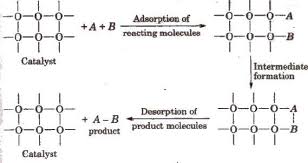
8. Why is adsorption always exothermic?
Ans. Adsorption is always exothermic. This statement can be explained in two ways.
(i) Adsorption leads to a decrease in the residual forces on the surface of the adsorbent. This causes a decrease in the surface energy of the adsorbent. Therefore, adsorption is always exothermic.
(ii) of adsorption is always negative. When a gas is adsorbed on a solid surface, its movement is restricted leading to a decrease in the entropy of the gas i.e., is negative. Now for a process to be spontaneous, should be negative.
is negative. Now for a process to be spontaneous, should be negative.
Therefore,. Since is negative, is more negative than which make negative. Hence, adsorption is always exothermic.
9. How are the colloidal solutions classified on the basis of physical states of the dispersed phase and dispersion medium?
Ans. One criterion for classifying colloids is the physical state of the dispersed phase and dispersion medium. Depending upon the type of the dispersed phase and dispersion medium (solid, liquid, or gas), there can be eight types of colloidal systems.
| Dispersed phase | Dispersion medium | Type of colloid | Examples |
| solid | solid | solid sol | Some coloured glasses and gem stones |
| solid | Liquid | Sol | Paints , cell fluid |
| Solid | Gas | Aerosol | Smoke, Dust. |
| Liquid | solid | Gel | Cheese, butter, jellies |
| Liquid | Liquid | Emulsion | Milk, hair cream |
| Liquid | Gas | Aerosol | Fog, Mist, Cloud, insecticide sprays |
| Gas | Solid | Solid sol | Pumice stone, foamrubber |
| Gas | Liquid | Foam | Froth, whipped cream, soap-lather. |
10. Discuss the effect of pressure and temperature on the adsorption of gases on solids.
Ans. Effect of pressure: Adsorption of a gas by an adsorbent depends upon the pressure of the gas. Initially the amount of gas adsorbed for a given amount of adsorbent (x/m) increases rapidly with increase in pressure. However, as the pressure becomes high and almost the entire surface of the adsorbent gets saturated with the gas, the effect of pressure becomes very small. Ultimatly, a stage is reached when no more adsorption occurs even if the pressure is increased. This stage is known as saturation stage and pressure applied is known as saturation pressure.
Effect of temperature: Temperature has different effect in physisorption and chemisorption.
a) In Physisorption: An increase in temperature will favour the desorption process because molecules of adsorbate get energy and leave the surface so rate of adsorbate decreases with increase in temperature. A ggraph plotted between amount of a gas adsorbed and temperature at a constant pressure is nown as adsorption isobar.
b) In Chemisorption: With initial rise in temperature, the rate of adsorption increases but with further rise in tempetaure, after a certain limit, adsorption statrs decreaseing. This is because an initial rise in temperature will provide the molecules necessary activation energy for chemical bond formation so rate of adsorption increases. At a certain temperature all the bonds are formed and now the further increases in temperature will favour desoption i.e. rate of adsorption now starts decreasing.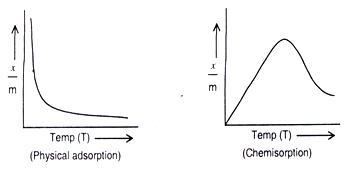
11. What are lyophilic and lyophobic sols? Give one example of each type. Why are hydrophobic sols easily coagulated?
Ans. (i) Lyophilic sols: Colloidal sols that are formed by mixing substances such as gum, gelatin, starch, etc. with a suitable liquid (dispersion medium) are called lyophilic sols. These sols are reversible in nature i.e., if two constituents of the sol are separated by any means (such as evaporation), then the sol can be prepared again by simply mixing the dispersion medium with the dispersion phase and shaking the mixture.
(ii) Lyophobic sols:When substances such as metals and their sulphides etc. are mixed with the dispersion medium, they do not form colloidal sols. Their colloidal sols can be prepared only by special methods. Such sols are called lyophobic sols. These sols are irreversible in nature. For example: sols of metals.
Now, the stability of hydrophilic sols depends on two things- the presence of a charge and the solvation of colloidal particles. On the other hand, the stability of hydrophobic sols is only because of the presence of a charge. Therefore, the latter are much less stable than the former. If the charge of hydrophobic sols is removed (by addition of electrolytes), then the particles present in them come closer and form aggregates, leading to precipitation.
12. What is the difference between multimolecular and macromolecular colloids? Give one example of each. How are associated colloids different from these two types of colloids?
Ans.
| S.No. | Multimolcular colloids | Macromolecular colloids |
| 1. | The particle size is less than that of colloidal range. | The particle size falls in the colloidal range. |
| 2. | They exist as aggregate of smaller particles. | These are already macromolecules in nature. |
| 3. | These are mostly lyophobhic colloids. | These are mostly lyophilic colloids. |
| 4. | Examples: gold sol and sulphur sol. | Examples: Starch, nylon, cellulose etc. |
Difference between associted colliods, multimolecular and macromolecular colloids.
Multimolecular colliods are formed by the aggregation of a large number of simpe molecules, macromolecules having size in the collidal range.
On the other hand, associted colloids also called micelles, are generally electrolytes. they exist as ions at low concentration. However, above a particular concentration called critical micelle concentration(CMC) and above a particular temperature called kraft temperature (Tk), these get associated and exhibits colloidal behaviour. Soap is a common example of associated colloid.
13. What are enzymes? Write in brief the mechanism of enzyme catalysis.
Ans. Enzymes: Enzymes are basically protein molecules of high molecular masses. These form colloidal solutions when dissolved in water. These are complex, nitrogenous organic compounds produced by living plants and animals. Enzymes are also called 'biochemical catalysts'. e.g.
Mechanism of enzyme catalysis: The mechanism of enzyme ctatlysed reaction has been proposed ny Menton and Michaelis and is completed in the following steps:
Step 1: Binding enzme to substrate (reactant) to form a complex:
Step 2: product formation in the complex:
Step 3: Release of the product from the enzyme product complex:
On the surface of the enzymes, various cavities are present with characteristic shapes. These cavities possess active groups such as -NH2, -COOH etc. The reactant molecules having a complementary shape fit into the cavities just like a key fits into a lock. This leads to the formation of an activated complex. This complex then decomposes to give the product and releases the enzyme catalyst as shown above in reaction mechanism.
14. How are colloids classified on the basis of
(i) Physical states of components
(ii) Nature of dispersion medium and
(iii) Interaction between dispersed phase and dispersion medium?
Ans. Colloids can be classified on various basis:
(i) On the basis of the physical state of the components (by components we mean the dispersed phase and dispersion medium). Depending on whether the components are solids, liquids, or gases, we can have eight types of colloids.
| Dispersed phase | Dispersion medium | Type of colloid | Examples |
| solid | solid | solid sol | Some coloured glasses and gem stones |
| solid | Liquid | Sol | Paints , cell fluid |
| Solid | Gas | Aerosol | Smoke, Dust. |
| Liquid | solid | Gel | Cheese, butter, jellies |
| Liquid | Liquid | Emulsion | Milk, hair cream |
| Liquid | Gas | Aerosol | Fog, Mist, Cloud, insecticide sprays |
| Gas | Solid | Solid sol | Pumice stone, foamrubber |
| Gas | Liquid | Foam | Froth, whipped cream, soap-lather |
(ii) On the basis of the dispersion medium, sols can be divided as:
| Dispersion medium | Name of sol |
| Water | Aqua sol or hydrosol |
| Alcohol | Alco sol |
| Benzene | Benzosol |
| Gases | Aerosol |
(iii) On the basis of the nature of the interaction between the dispersed phase and dispersion medium, the colloids can be classified as lyophilic (solvent attracting) and lyophobic (solvent repelling).
(i) Lyophilic sols: Colloidal sols that are formed by mixing substances such as gum, gelatin, starch, etc. with a suitable liquid (dispersion medium) are called lyophilic sols. These sols are reversible in nature i.e., if two constituents of the sol are separated by any means (such as evaporation), then the sol can be prepared again by simply mixing the dispersion medium with the dispersion phase and shaking the mixture.
(ii) Lyophobic sols:When substances such as metals and their sulphides etc. are mixed with the dispersion medium, they do not form colloidal sols. Their colloidal sols can be prepared only by special methods. Such sols are called lyophobic sols. These sols are irreversible in nature. For example: sols of metals.
Chapter End Question
15. Explain what is observed
(i) When a beam of light is passed through a colloidal sol.
(ii) An electrolyte, NaCl is added to hydrated ferric oxide sol.
(iii) Electric current is passed through a colloidal sol?
Ans. (i) When a beam of light is passed through a colloidal solution,placed in dark room the beam of light is scattered by the colloidal particles and the pathe of the light becomes visible. This is known as the Tyndall effect.
(ii) When NaCl is added to ferric oxide sol, it dissociates to give Na+ and Cl- ions. Particles of ferric oxide sol are positively charged. Thus, they get coagulated in the presence of negatively charged Cl- ions.
(iii) The colloidal particles are charged and carry either a positive or negative charge.When electric current is passed through a colloidal solution, the dispersed phase move towards oppositely charged electrodes. On reaching the elctrode, they lose their charge and get coagulated.(electrophoresis)
16. What are emulsions? What are their different types? Give example of each type.
Ans. The colloidal solution of two immiscible liquids in which both the dispersed phase and dispersion medium are liquids is called an emulsion.Since dispersed phase and dispersion do not mix well, the emulsion is generally unstable and is stabilised by adding a suitable reagent called emulsifier or emulsifying agent like soap, gum etc.
There are two types of emulsions:
(a) Oil in water type:
Here, oil is the dispersed phase while water is the dispersion medium. For example: milk, vanishing cream, etc.
(b) Water in oil type:
Here, water is the dispersed phase while oil is the dispersion medium. For example: cold cream, butter, etc.
17. What is demulsification? Name two demulsifiers.
Ans. The process of decomposition of an emulsion into its constituent liquids is called demulsification. Examples of demulsifiers are surfactants, ethylene oxide, etc.
18. Action of soap is due to emulsification and micelle formation. Comment.
Ans. The cleansing action of soap is due to emulsification and micelle formation. Soaps are basically sodium and potassium salts of long chain fatty acids having general formula, R-COO-Na+. The end of the molecule to which the sodium is attached is polar in nature, while the alkyl-end is non-polar. Thus, a soap molecule contains a hydrophilic (polar) and a hydrophobic (non-polar) part.
When soap is added to water containing dirt, the soap molecules surround the dirt particles in such a manner that their hydrophobic parts get attached to the dirt molecule and the hydrophilic parts point away from the dirt molecule. This is known as micelle formation. Thus, we can say that the polar group dissolves in water while the non-polar group dissolves attracts the dirt particle. Now, as these micelles are negatively charged, they do not coalesce and a stable emulsion is formed.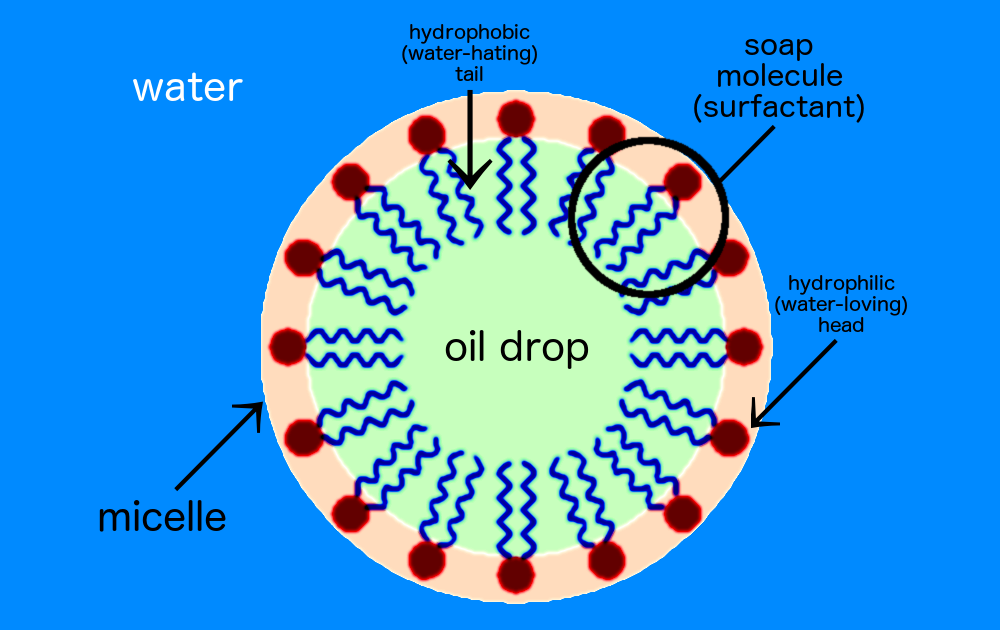
19. Give four examples of heterogeneous catalysis.
Ans. (i) Oxidation of sulphur dioxide to form sulphur trioxide. In this reaction, V2O5 acts as a catalyst used in the manufacture of H2SO4 by contact process.
(ii) Formation of ammonia by the combination of dinitrogen and dihydrogen in the presence of finely divided iron.
This process is called the Haber's process.
(iii) Oswald's process: Oxidation of ammonia to nitric oxide in the presence of platinum.
(iv) Hydrogenation of vegetable oils in the presence of Ni.
vegetable ghee(s)
20. What do you mean by activity and selectivity of catalysts?
Ans. (a) Activity of a catalyst:The activity of a catalyst is its ability to increase the rate of a particular reaction. Chemisorption is the main factor in deciding the activity of a catalyst. The adsorption of reactants on the catalyst surface should be neither too strong nor too weak. It should just be strong enough to make the catalyst active. e.g. H2 and O2 do not react to form water even if kept for indefinite period but in the presence of platinum catalyst, the reaction takes place with explosion.
(b) Selectivity of the catalyst:The ability of the catalyst to direct a reaction to yield a particular product is referred to as the selectivity of the catalyst. For example, by using different catalysts, we can get different products for the reaction between H2 and CO.
(i)
(ii)
(iii)
21. Describe some features of catalysis by zeolites.
Ans. Zeolites are alumino-silicates that are micro-porous in nature with general formula . Where, n = valency of cation. Their pore size varies from 260pm to 740pm.
Zeolites have a honeycomb-like structure, which makes them shape-selective catalysts. They have an extended 3D-network of silicates in which some silicon atoms are replaced by aluminium atoms, giving them an Al-O-Si framework. The reactions taking place in zeolites are very sensitive to the pores and cavity size of the zeolites. Zeolites are commonly used in the petrochemical industry. An important zeolite used in the petroleum industry is ZSM-5 (Zeolite sieve of molecular porosity5).It converts alcohol into petrol
22. What is shape selective catalysis?
Ans. A catalytic reaction which depends upon the pore structure of the catalyst and on the size of the reactant and the product molecules is called shape-selective catalysis. For example, catalysis by zeolites is a shape-selective catalysis. The pore size present in the zeolites ranges from 260-740 pm. Thus, molecules having a pore size more than this cannot enter the zeolite and undergo the reaction.
23. Explain the following terms:
(i) Electrophoresis
(ii) Coagulation
(iii) Dialysis
(iv) Tyndall effect.
Ans. (i) Electrophoresis:The movement of colloidal particles under the influence of an applied electric field is known as electrophoresis. Positively charged particles move to the cathode, while negatively charged particles move towards the anode. As the particles reach oppositely charged electrodes, they become neutral and get coagulated.For example, the solution of gold, Arsenic sulphide(As2S3)are negatively charged and the particles move towards the positive electrode while those of Fe(OH)3, Al(OH)3 have positive charge and the particles move towards the negative electrode.
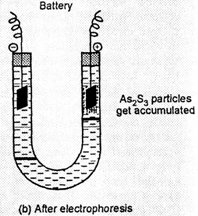
(ii) Coagulation:The process of settling down of colloidal particles i.e., conversion of a colloid into a precipitate is called coagulation or Flocculation.
Mechanism of Coagulation: The particles of the dispersed phase i.e. Colloids bear some charge.When an electrolyte is added to the sol, the colloidal particles take up ions carrying opposite cahrge from the elctrolyte .As a result, their charge gets neutralised and this causes the uncharged particles to come closer and to get coagulated.For example, if BaCl2 solution is added to As2S3 sol, Ba2+ ions are attracted by the negatively charged colliodal particles of As2S3 sol and their charge gets neutralised. This leads to coagulation.
(iii) DialysisThe process of removing a dissolved substance from a colloidal solution by the means of diffusion through a membrane is known as dialysis. This process is based on the principle that ions and small molecules can pass through animal membranes unlike colloidal particles.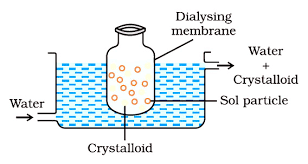
This process is slow and time consuming.Thus, to fasten the process, an elctric feild is applied and the process is known as electrodialysis.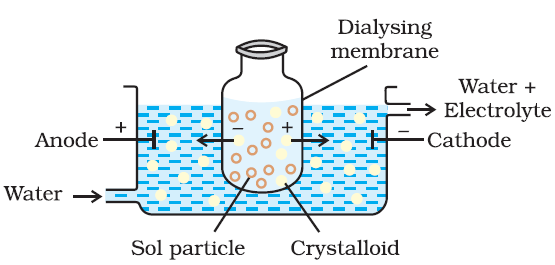
(iv) Tyndall effect:When a beam of light is allowed to pass through a colloidal solution, it becomes visible like a column of light. This is known as the Tyndall effect. This phenomenon takes place as particles of colloidal dimensions’ scatter light in all directions.
24. Give four uses of emulsions.
Ans. Four uses of emulsions:
(i) Cleansing action of soaps is based on the formation of emulsions.
(ii) Digestion of fats in intestines takes place by the process of emulsification.
(iii) Antiseptics and disinfectants when added to water form emulsions.
(iv) The process of emulsification is used to make medicines.
25. Give four uses of emulsions.
Ans. Four uses of emulsions:
(i) Cleansing action of soaps is based on the formation of emulsions.
(ii) Digestion of fats in intestines takes place by the process of emulsification.
(iii) Antiseptics and disinfectants when added to water form emulsions.
(iv) The process of emulsification is used to make medicines.
26. Explain the terms with suitable examples:
(i) Alcosol
(ii) Aerosol
(iii) Hydrosol
Ans. (i) Alcosol: A colloidal solution having alcohol as the dispersion medium and a solid substance as the dispersed phase is called an alcosol. For example: colloidal sol of cellulose nitrate in ethyl alcohol is an alcosol.
(ii) Aerosol: A colloidal solution having a gas as the dispersion medium and a solid as the dispersed phase is called an aerosol. For example: fog
(iii) Hydrosol: A colloidal solution having water as the dispersion medium and a solid as the dispersed phase is called a hydrosol. For example: starch sol or gold sol
27. Comment on the statement that "colloid is not a substance but a state of substance".
Ans. Common salt (a typical crystalloid in an aqueous medium) behaves as a colloid in a benzene medium. Hence, we can say that a colloidal substance does not represent a separate class of substances. When the size of the solute particle lies between 1 nm and 1000 nm, it behaves as a colloid. Hence, we can say that colloid is not a substance but a state of the substance which is dependent on the size of the particle. A colloidal state is intermediate between a true solution and a suspension.